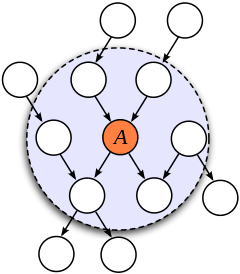Markov blanket

In machine learning, the Markov blanket for a node in a Bayesian network is the set of nodes composed of 's parents, its children, and its children's other parents. In a Markov random field, the Markov blanket of a node is its set of neighboring nodes. A Markov blanket may also be denoted by .
Every set of nodes in the network is conditionally independent of when conditioned on the set , that is, when conditioned on the Markov blanket of the node . The probability has the Markov property; formally, for distinct nodes and :
The Markov blanket of a node contains all the variables that shield the node from the rest of the network. This means that the Markov blanket of a node is the only knowledge needed to predict the behavior of that node. The term was coined by Judea Pearl in 1988.[1]
In a Bayesian network, the values of the parents and children of a node evidently give information about that node; however, its children's parents also have to be included, because they can be used to explain away the node in question. In a Markov random field, the Markov blanket for a node is simply its adjacent nodes.
See also
Notes
- ↑ Pearl, Judea (1988). Probabilistic Reasoning in Intelligent Systems: Networks of Plausible Inference. Representation and Reasoning Series. San Mateo CA: Morgan Kaufmann. ISBN 0-934613-73-7.